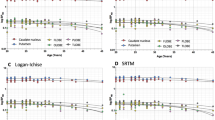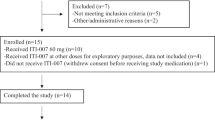Abstract
Positron emission tomography (PET) and11C-raclopride were used to assess the time course of binding to central dopamine D2 receptors by the novel neuroleptic ziprasidone. In a third party blind study, six healthy male control subjects received a predose of 40 mg ziprasidone and were scanned at an interval of between 4 and 36 h post-dose. One additional subject was assigned to placebo predose and was scanned at 4 h post-dose. Binding potential (BP) was compared with that seen in the subject predosed with placebo and with that seen in nine unmedicated normal volunteers. Subjects studied up to 12 h post-dose had BPs that were greater than 2 SD less than the mean BP, indicative of extensive D2 receptor binding by ziprasidone. With increasing time between dosing and PET scanning there was a curvilinear increase in BP, so that all studies performed at or after 18 h post-dose gave BPs in the normal range (mean±2 SD). Elevated prolactin levels returned to within the normal range by 18 h post-dose. PET measures of binding potential correlated significantly with serum levels of ziprasidone at the time of scanning and less significantly with absolute prolactin levels at the same time.
Similar content being viewed by others
References
Antonini A, Leenders KL, Reist H, Thomann R, Beer H-F, Locher J (1993) Effect of age on D2 dopamine receptors in normal human brain measured by positron emission tomography and11C-raclopride. Arch Neurol 50:474–480
Baron JC, Martinot JL, Cambon H, Boulenger JP, Poirier MF, Caillard V, Blin J, Huret JD, Loc'h C, Maziere B (1989) Striatal dopamine receptor occupancy during and following withdrawal from neuroleptic treatment: correlative evaluation by positron emission tomography and plasma prolactin levels. Psychopharmacology 99:463–472
Bench CJ, Lammertsma AA, Dolan RJ, Grasby PM, Warrington SJ, Gunn K, Cuddigan M, Turton DJ, Osman S, Frackowiak RSJ (1993) Dose dependent occupancy of central dopamine D2 receptors by the novel neuroleptic CP-88,059-01: a study using positron emission tomography and11C-raclopride. Psychopharmacology 112:308–314
Bunney BS, Grace AA (1978) Acute and chronic haloperidol treatment: comparison of effects on nigral dopaminergic cell activity. Life Sci 23:1715–1727
Burt DR, Creese I, Snyder SH (1977) Antischizophrenic drugs: chronic treatment elevated dopamine receptor binding in brain. Science 196:326–328
Cambon H, Baron JC, Boulenger J-P, Loc'h C, Zarifian E, Maziere B (1987) In vivo assay for neuroleptic receptor binding in the striatum. Positron tomography in humans. Br J Psychiatry 151:824–830
Carson RE (1986) Parameter estimation in positron emission tomography. In: Phelps M, Mazziotta J, Schelbert H (eds) Positron emission tomography and autoradiography: principles and applications for the brain and heart. Raven Press, New York, pp 347–390
Chiodo LA, Bunney BS (1985) Possible mechanisms by which repeated clozapine administration differentially affects the activity of two subpopulations of midbrain dopamine neurons. J Neurosci 5:2539–2544
Clow A, Theodorou A, Jenner P, Marsden CD (1980) Changes in rat striatal dopamine turnover and receptor activity during one year's neuroleptic administration. Eur J Pharmacol 63:135–144
Creese I, Burt DR, Snyder SH (1976) Dopamine receptor binding predicts clinical and pharmacological potencies of antischizophrenic drugs. Science 192:481–483
Farde L, Hall H, Ehrin E, Sedvall G (1986) Quantitative analysis of D2 dopamine receptor binding in the living human brain by PET. Science 231:258–261
Farde L, Pauli S, Hall H, Eriksson L, Halldin C, Hogeberg T, Nilsson L, Sjogren I, Stone-Elander S (1988a) Stereoselective binding of [11C]raclopride in living human brain — a search for extrastriatal central D2-dopamine receptors by PET. Psychopharmacology 94:471–478
Farde L, Wiesel FA, Halldin C, Sedvall G (1988b) Central D2-dopamine receptor occupancy in schizophrenic patients treated with antipsychotic drugs. Arch Gen Psychiatry 45:71–76
Farde L, Wiesel FA, Nordstrom A-L, Sedvall G (1989) D1-and D2-dopamine receptor occupancy during treatment with conventional and atypical neuroleptics. Psychopharmacology 99:S28-S31
Farde L, Wiesel FA, Stone-Elander S, Halldin C, Nordstrom A-L, Hall H, Sedvall G (1990) D2 dopamine receptors in neuroleptic-naive schizophrenic patients. Arch Gen Psychiatry 47:213–219
Farde L, Nordstrom A-L, Wiesel FA, Pauli S, Halldin C, Sedvall G (1992) Positron emission tomographic analysis of central D1 and D2 dopamine receptor occupancy in patients treated with classical neuroleptics and clozapine. Relation to extrapyramidal side effects. Arch Gen Psychiatry 49:538–544
Forsman A, Ohman R (1977) Applied pharmacokinetics of haloperidol in man. Curr Ther Res 21:396–411
Hershon HI, Kennedy PF, McGuire RJ (1972) Persistence of extrapyramidal disorders and psychiatric relapse after withdrawal of long-term phenothiazine therapy. Br J Psychiatry 120:41–50
Hume SP, Myers R, Bloomfield PM, Opacka-Juffry J, Cremer JE, Athier RG, Luthra SK, Brooks DJ, Lammerstma AA (1992) Quantitation of carbon-11 labelled raclopride in rat striatum using positron emission tomography. Synapse 12:47–54
Itoh H, Yagi G, Tateyama M, Fujii Y, Iwamura K, Ichikawa K (1984) Monitoring of haloperidol serum levels and its clinical significance. Prog Neuropsychopharmacol Biol Psychiatry 8:51–62
Maurer E, Deutsch G, Burg J, Deeg R, Waklefield A (1986) Rapid direct measurement of prolactin in serum by one-step enzyme immunoassay. A presentation of the Boehringer Mannheim Research Group. Joint meeting of the AACC and CSCC, Chicago, July 1986
Peroutka SJ, Snyder SH (1980) Relationship of neuroleptic drug effects at brain dopamine, serotonin, alpha-adrenergic and histamine receptors to clinical potency. Am J Psychiatry 137:1518–1522
Sawle GV, Colebatch JG, Shah A, Brooks DJ, Marsden CD, Frackowiak RSJ (1990) Striatal function in normal ageing: implications for Parkinson's disease. Ann Neurol 28:799–804
Seeman P, Lee T, Chau-Wong M, Wong K (1976) Antipsychotic drug doses and neuroleptic/dopamine receptors. Nature 261:717–719
Seymour PA, Seeger TF, Guanowsky V, Robinson GL, Howard H, Heym J (1993) Behavioural pharmacology of CP-88,059: a new antipsychotic with both 5-HT2 and D2 antagonist activities. Soc Neurosci Abstr 19:599
Smith M, Wolf AP, Brodie JD, Arnett CD, Barouche F, Schiue CY, Fowler JS, Russel JAG, MacGregor RR, Wolkin A, Angrit B, Rotrosen J, Peselow E (1988) Serial18F-N-methylspiroperidol PET studies to measure changes in antipsychotic drug D2 receptor occupancy in schizophrenic patients. Biol Psychiatry 23:653–663
Spinks TJ, Jones T, Gilardi MC, Heather JD (1988) Physical performance of the latest generation of commercial positron scanner. IEEE Trans Nucl Sci 35:721–725
Zetterstom T, Sharp T, Ungerstedt U (1984) Effect of neuroleptic drugs on striatal dopamine release and metabolism in the awake rat studied by intracerebral dialysis. Eur J Pharmacol 106:27–37
Zhang W, Tilson H, Stachowiak MK, Hong JS (1989) Repeated haloperidol administration changes basal release of striatal dopamine and subsequent response to haloperidol challenge. Brain Res 484:389–392
Zorn SH, Morrone JM, Seeger TF, Jackson E, Johnson C, Lebel L, Howard H, Heym J (1993) The antipsychotic drug CP-88,059 is an antagonist at both 5HT2 and 5HT1C receptors. Soc Neurosci Abstr 19:599
Author information
Authors and Affiliations
Rights and permissions
About this article
Cite this article
Bench, C.J., Lammerstma, A.A., Grasby, P.M. et al. The time course of binding to striatal dopamine D2 receptors by the neuroleptic ziprasidone (CP-88,059-01) determined by positron emission tomography. Psychopharmacology 124, 141–147 (1996). https://doi.org/10.1007/BF02245614
Received:
Revised:
Issue Date:
DOI: https://doi.org/10.1007/BF02245614




